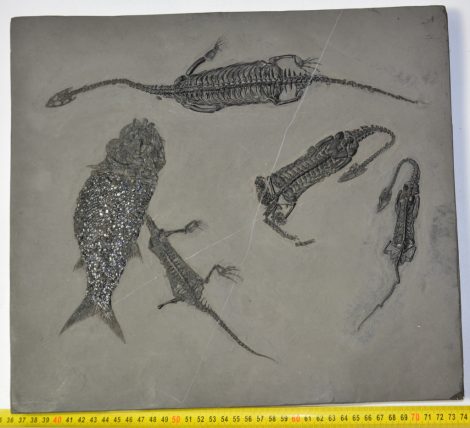- New arrivals
- Products in stock
- Mammuthus fossils [504]
- Megaloceros deer fossils [22]
- Bison Bos fossil [32]
- Rhinoceros fossil [35]
- Echinoderms sea urchin fossil [26]
- Plant wood fossils [33]
- Fish and shark fossils [49]
- Ammonites cephalopods [26]
- Mammalian vertebrates fossils [75]
- Dinosaurus fossil [47]
- Shells fossils [11]
- Gastropods fossils [28]
- Coral fossils [5]
- Trilobites & Crabs fossils [26]
- Minerals [22]
- Insect fossils [17]
- Other Fossils [15]
- Books, literature [10]
4 Kechiosaurus hui and one Asialepidotus shingyiensis fish fossil
Early Triassic age (approx. 242 - 240 million years old) Asialepidotus shingyiensis fish fossil and four piece Keichousaurus hui skeleton on a stone slab. The place of origin of Keichousaurus fossils is China, Guizhou province, Guanglin, Huxia formation. The size of the sheet containing Kechousaurus and the fish fossil is approx.: length 375 mm, width: between 337 - 338 mm, thickness between 25 -29 mm. The distance between the nose and the end of the tail of the largest Keichousaurus is 330 mm. The weight of the slab is approx. 7.2 Kg + packaging. This is an exceptionally large specimen. The average size of mature Kechiosaurus specimens (14.9 cm for females and 16.1 cm for males) The length of Asialepidotus measured to the end of the tail fin is 198 mm. It is an extremely rare find to have 4 Kechiosaurus and a whole fish fossilized on one stone slab. The teeth of two Kechiosaurus are also nicely visible. The fossils are very nicely prepared. Another sheet was glued to the thin stone slab with synthetic resin, so there is no need to be afraid of the slab breaking easily as in the case of slabs without reinforcement.









